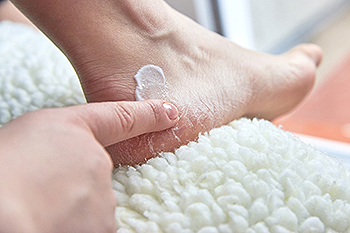Cracked heels, or heel fissures, can develop when skin on the heel dries out and becomes callused. This dried out skin can then crack when weight placed on the heel causes the fat pad under the heel to spread out. If these cracks are left untreated, they can deepen to the point where they bleed or even become infected. This is not only painful, but can be very dangerous—especially for individuals with diabetes. Certain factors—along with having dry, thickened skin—can contribute to the formation of cracked heels, such as standing for prolonged periods of time, going barefoot, wearing open-backed shoes, and carrying extra weight. Also, diabetes, hypothyroidism, atopic dermatitis, psoriasis, and other conditions that can cause dry skin can be associated with cracked heels. Sometimes, cracked heels can be lessened by using topical water-retaining creams. If your cracked heels do not improve with regular moisturizing, if they are deep or bloody, or if you have diabetes, it is suggested that you seek professional treatment from a podiatrist.
Cracked heels are unsightly and can cause further damage to your shoes and feet. If you have any concerns, contact Edwin Oghoorian, DPM from Pacific Foot & Ankle Associates . Our doctor can provide the care you need to keep you pain-free and on your feet.
Cracked Heels
Cracked heels appear unappealing and can make it harder for you walk around in sandals. Aside from looking unpleasant, cracked heels can also tear stockings, socks, and wear out your shoes. There are several methods to help restore a cracked heel and prevent further damage.
How Do You Get Them?
Dry skin is the number one culprit in creating cracked heels. Many athletes, walkers, joggers, and even swimmers suffer from cracked heels. Age and skin oil production play a role to getting cracked heels as well.
Promote Healing
Over the counter medicines can help, especially for those that need instant relief or who suffer from chronic dry feet.
Wear Socks – Wearing socks with medicated creams helps lock in moisture.
Moisturizers – Applying both day and night will help alleviate dryness which causes cracking.
Pumice Stones – These exfoliate and remove dead skin, which allows for smoother moisturizer application and better absorption into the skin.
Change in Diet
Eating healthy with a well-balanced diet will give the skin a fresh and radiant look. Your body responds to the kinds of food you ingest. Omega-3 fatty acids and zinc supplements can also revitalize skin tissue.
Most importantly, seek professional help if unsure how to proceed in treating cracked heels. A podiatrist will help you with any questions or information needed.
If you have any questions, please feel free to contact our office located in San Dimas, CA . We offer the newest diagnostic and treatment technologies for all your foot care needs.
Read more about Solutions for Cracked Heels
